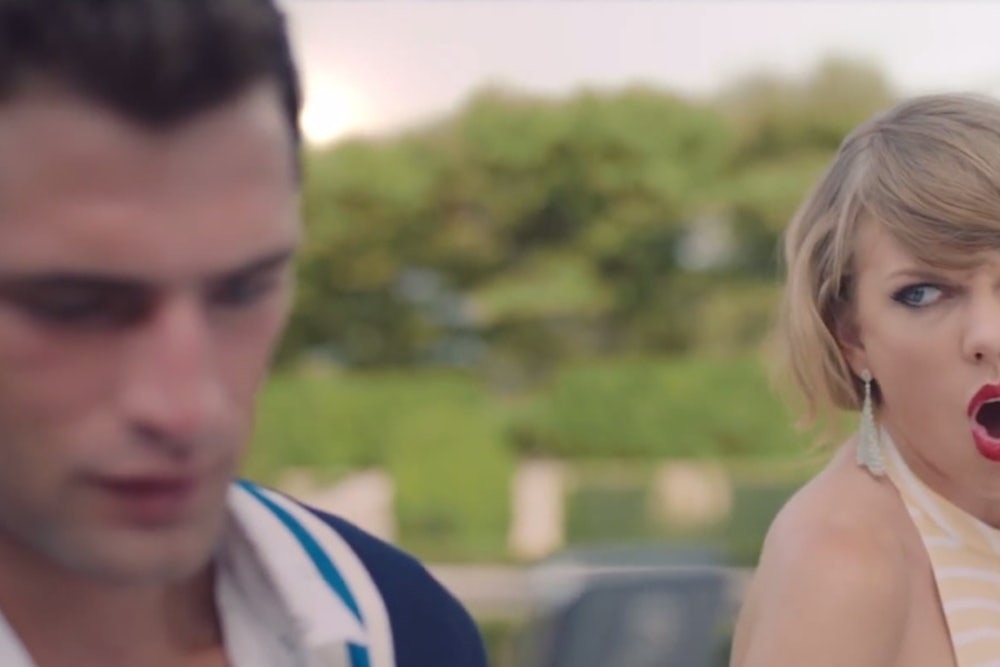Taylor Swift’s “Blank Space” music video, released this week, is a self-aware satirization of the star’s own image. It capitalizes on Swift’s reputation for clinginess, ironically chastising those who have criticized her for singing about her love life—or for having such a prolific love life, or, really, for having a love life at all.
The video for the song—a single from her latest album, 1989—opens with images from a fairytale romance: Swift and her broad-shouldered beau in formal attire, eating in a lavish dining room; frolicking on the grounds of a sprawling estate, laughing in slow motion; gazing at each other tenderly across the threshold of a Shakespearian balcony; and, finally, carving their initials into a tree like a pair of lovesick teenagers. “You’re the king, baby, I’m your queen,” Taylor croons as she and her lover oh-so-quirkily ride their matching vintage bikes around her palatial living room.

But halfway through the video, Swift violently dismantles this picture of romantic bliss: she berates her boyfriend, drops his phone into a fountain, smashes his sports car with a golf club, and takes an axe to the tree bearing the couple’s initials. It turns out that the balcony scene—ostensibly the sweet stuff of rom-com reverie—transpired mere moments before Swift sets fire to her boyfriend’s clothing and hurls it at him. “Got a long list of ex-lovers/they’ll tell you I’m insane,” she sings, “cause you know I love the players/and you love the game.” At the end of the video, she admits another generically handsome man into her mansion, glancing conspiratorially at the camera before the shot fades to black.
CNN summarized the video as “Taylor Swift Goes Crazy.” US Weekly, following in CNN’s painfully oblivious footsteps, pronounced that “Taylor Becomes Psycho Ex-Girlfriend, Wields a Knife and an Axe in ‘Blank-Space’ Music Video.” Even the few commentators who have eschewed more facile characterizations have misinterpreted “Blank Space’s” message. In Slate, Forrest Wickman argues that the video represents Swift’s attempt to acknowledge and discredit the charges levied against her: “I know what you’re saying about me, and it’s not true! I’m not crazy!” she seems to be protesting. In this picture, the burden falls on Swift to defend herself—because being “crazy,” whatever that means, is bad.
But “Blank Space” is more than self-defense. The video is not so much a vindication of sane Taylor as a vindication of “crazy” Taylor, the Taylor-who-has-feelings-and-sings-about-them. It amounts to a celebration of the raw vulnerability that has characterized so much of Swift’s music and attracted so much negative (and positive) attention. The Swift who features in the “Blank Space” video doesn’t make “crazy” look like something to disavow or apologize for: she makes it look cool.
For centuries, “crazy” women have been beholden not only to their husbands but also to their disorders, literally and figuratively “trapped” by systems they had no hand in creating. (See Jane Eyre, The Yellow Wallpaper, or just about any chapter from The Madwoman in the Attic.) Though they are sometimes sympathetic, they are thoroughly unenviable. In contrast, Swift is both crazy and in control. She is rich, beautiful, and commanding. Her mansion is arranged according to her eccentric tastes—she lounges in an enormous bed, flanked by two white horses—and she admits a series of men into a domain where she has set the terms. In the end, she virtually chases her beau off her property, although he seems contrite in the aftermath of her outburst. The takeaway from “Blank Space” is that Swift’s “crazy” is deliberate—not an act of compulsion but an act of agency. In contrast with Mrs. Rochester or the protagonist of The Yellow Wallpaper, women who are oppressed by their own neuroses, Swift endorses the way that she relates to the world.
Part of Swift’s strategy is a piece of ingenuous rebranding. She frames the “crazy” as youthful passion, in keeping with songs like Fun’s “We Are Young.” “We’re young and we’re reckless,” Swift sings, “we’ll take this way too far/and leave you breathless/or with a nasty scar.” Swift may not represent a paragon of romantic stability, but there’s something appealing about the sort of destructive, all-or-nothing love she champions.
The “Blank Space” video comes on the heels of the release of Gone Girl, another film that questions our conception of female “craziness.” Gone Girl was criticized for perpetuating stereotypes—for reinforcing the notion that the only alternative to the Cool Girl is the psychopathic ex run amok. And Swift may face similar critiques with the release of 1989.
But is Swift reinforcing stereotypes by offering up one more iteration of a jilted lover gone “crazy”? Or is she challenging the negative gloss we tend to give “craziness” in the first place? The “Blank Space” video seems to support the latter interpretation. The problem, Swift suggests, is how unaccountably disturbing we find art about women’s feelings—and the women who create it. Insanely ardent male protagonists abound in the Western canon: Romeo, John Keats, the hardboiled protagonist of Jean-Luc Godard’s Breathless, to name only a few. Women, on the other hand, are stuck with Glenn Close in Fatal Attraction.
And this is why the palpable, bombastic quality of Swift’s vengeance is so gratifying. In reality, her rampage would be decidedly unhinged. But as art—or at least, as pop culture—it makes for pointed and compelling commentary. She’s not Simone de Beauvoir, but it’s deeply satisfying to watch her invoke the motifs of gothic romance only to smash them to bits with a golf club.
